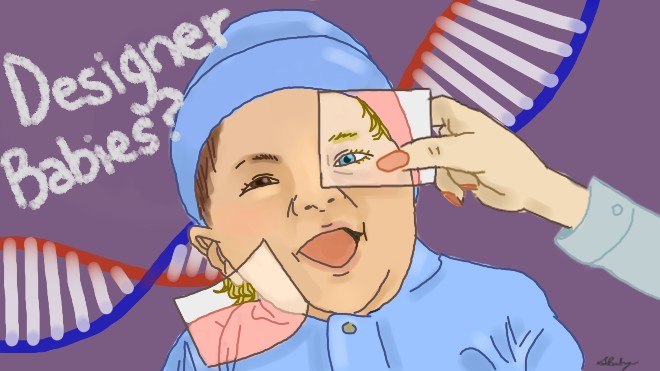The “Perfect” Generation
Picture by Sheehwa You
The future is here, and the concept of constructing the perfect child is not far from home. Parents can choose to give their baby boy beautiful blonde hair, bright blue eyes, and a gender swap so that he is now a she. Furthermore, the child’s risk of diabetes and obesity have been significantly reduced thanks to genetic modification. However, this selection of idealistic traits for children is risky, and may prove to be detrimental to future societies in numerous ways.
Embryos are checked by a process called preimplantation genetic diagnosis, which uses in-vitro fertilization. This means that the mother’s egg is taken out and artificially fertilized in a lab. After a certain stage of embryo development, two cells are removed and checked for defects and are then either re-implanted or discarded. CRISPR-Cas9 is a new technology created to allow scientists to alter parts of the genome by replacing and editing the DNA sequence.
This scientific breakthrough has the possibility of damaging our society both physically and ethically. Genetic modification is prone to mistakes. The creation of designer children is very meticulous, and as humans, we are known to make many miscalculations. Furthermore, this technology is fairly new and could take a while before the results can be more resolute. The alteration of a DNA sequence could also unexpectedly affect another trait of the child because DNA usually holds the instructions for more than just one function. This could leave the child with worse mutations than if the parent had let the child be born naturally.
Many individuals are concerned by the idea of genetic enhancement. Allowing scientists to “play God” and unnaturally modify babies leaves people unsettled and unsure. Another argument is that these babies do not have a say on whether or not they would want this procedure performed on them. Furthermore, the price range for creating the perfect baby costs twenty to a hundred thousand USD, leaving this as only an option for the rich, creating a larger margin between the already substantial gap between wealthy and poor.
This procedure could ruin humanity if it ever becomes affordable for the general public. Certain DNA sequences of the parents would be lost and not passed on to future generations, which could possibly disorient the gene pool. If certain physical traits were repeatedly chosen due to widespread appeal, genetic variation and individuality would be lost. Another concern is the discrimination against the unmodified by the “perfect” children or vice versa.
Although in-vitro fertilization and CRISPR-Cas9 have been theorized to reduce the risk of certain genetic diseases and encourage perfect physical attributes, it could also bring many unwanted consequences. Some of these include mutations, general public upset, loss of genetic individuality, and discrimination. Designer babies are not worth the price, risk, and potential societal disruption, especially while it is still in developmental stages.

Oh, hey! I didn’t see you there…
Can you believe it? Journalism for four years... I can feel my skin melding with the walls of this class and the...








